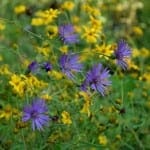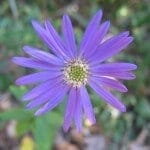- Pair Georgia aster with yellow fall flowers such as goldenrod (Solidago spp.) or sunflowers (Helianthus porteri shown here).
- Unopened disk flowers are light colored.
We are proud to announce that Georgia Native Plant Society’s Plant of the Year for 2015 is Georgia aster!
A sun loving plant, Georgia aster was once widespread across southeastern meadows and prairies, but is rare today because of habitat destruction and wildfire suppression. As the natural succession from field to forest progresses in meadows where Georgia aster grows, it can compete well for resources until it begins to be shaded out by woody plants. Georgia aster is endemic to (i.e. occurs only in) a total of about 34 counties in Georgia, Alabama, and the Carolinas. Disjunct populations have been reported in Leon County, Florida and possibly in Louisiana. Georgia aster’s rarity rank in Georgia is S2, meaning it is imperiled because of rarity or because other factors demonstrably make it very vulnerable to extinction. Its legal status in Georgia is threatened, meaning that it is likely to become an endangered species within the foreseeable future. It is currently a candidate for federal legal status.
Georgia aster’s native habitat is open, sunny areas, where it grows along edges and openings in rocky, upland oak-hickory-pine forests, and rights-of-way. The primary controlling factor for its occurrence seems to be the availability of sunlight.
Regarded as the aster with the brightest and most vividly bluish-purple flowers, Georgia aster blooms from late-September through November. The composite flowers are 2 to 2 ¾ inches wide, consisting of both small disk flowers in the center and long ray flowers that radiate from the center. The disk flowers are white at first and become reddish-purple as the bloom ages, the ray petals are bluish-violet, and the purple-tipped stamens produce white pollen. Its leaves, often seen in the middle part of the stem, clasp the stem. The stems grow 20 to 40 inches or taller, and the plant spreads by underground roots at a moderate rate to form a clump. Georgia aster can be distinguished from the similar late purple aster (Symphyotrichum patens) by its dark purple rays (compared to the light lavender rays of S. patens) and white to reddish-purple disk flowers (compared to the yellow disk flowers of S. patens).
Georgia aster is an excellent plant for the garden. It flowers more profusely in full sun, but it will tolerate filtered shade. It grows best in moderately acid to alkaline soils, is tolerant of various soil types, and prefers growing in drier sunny areas. Once established, it is very drought-tolerant. It grows happily in average soil with good drainage and as much sun exposure as possible. It is a wonderful choice for planting in a perennial border or in a native meadow garden. The abundant and spectacular flowers look lovely scrambling over the garden in late fall, but its height can be controlled by cutting it back about 50% in mid-summer, which will result in shorter, more erect stems.



